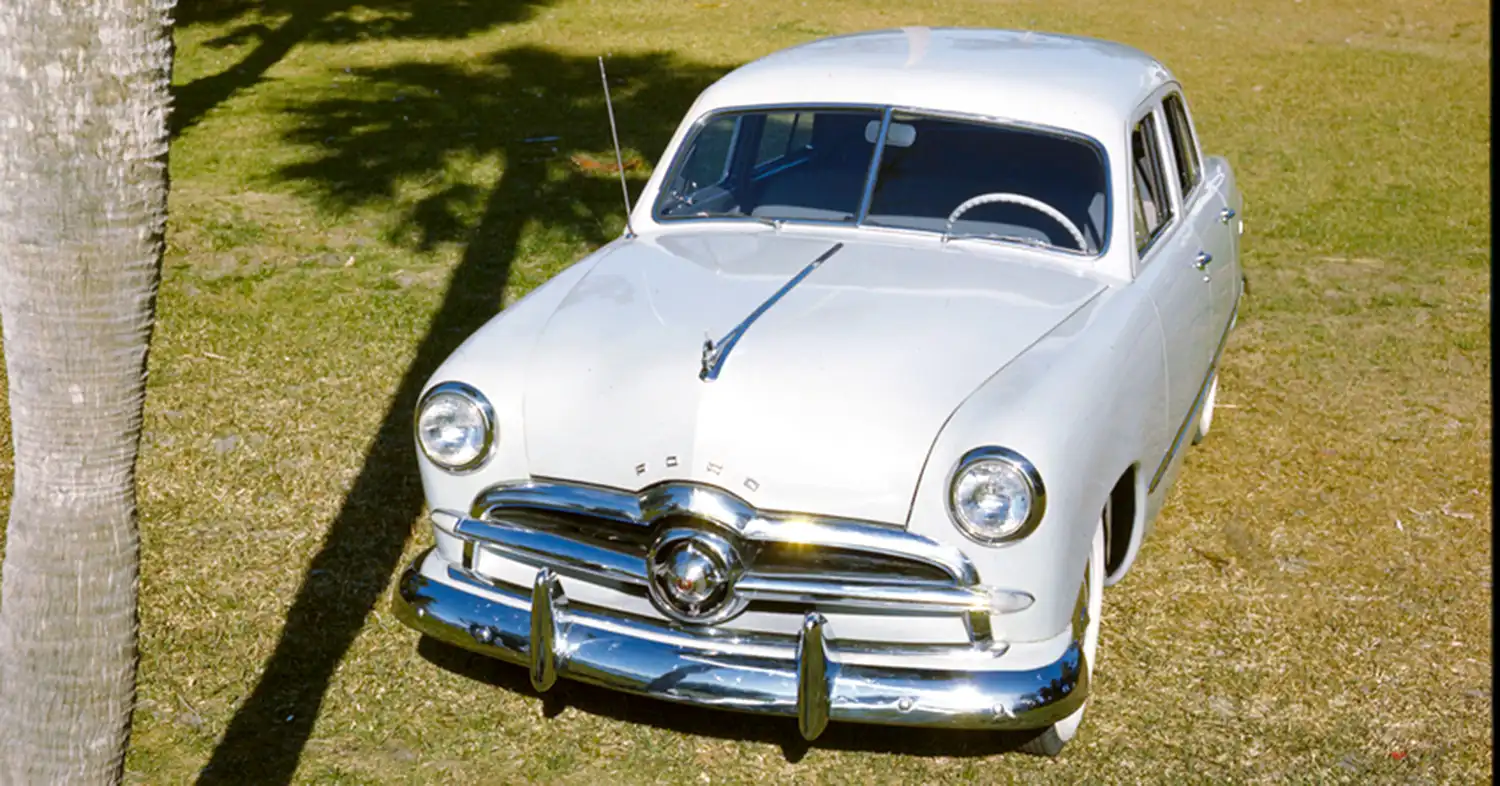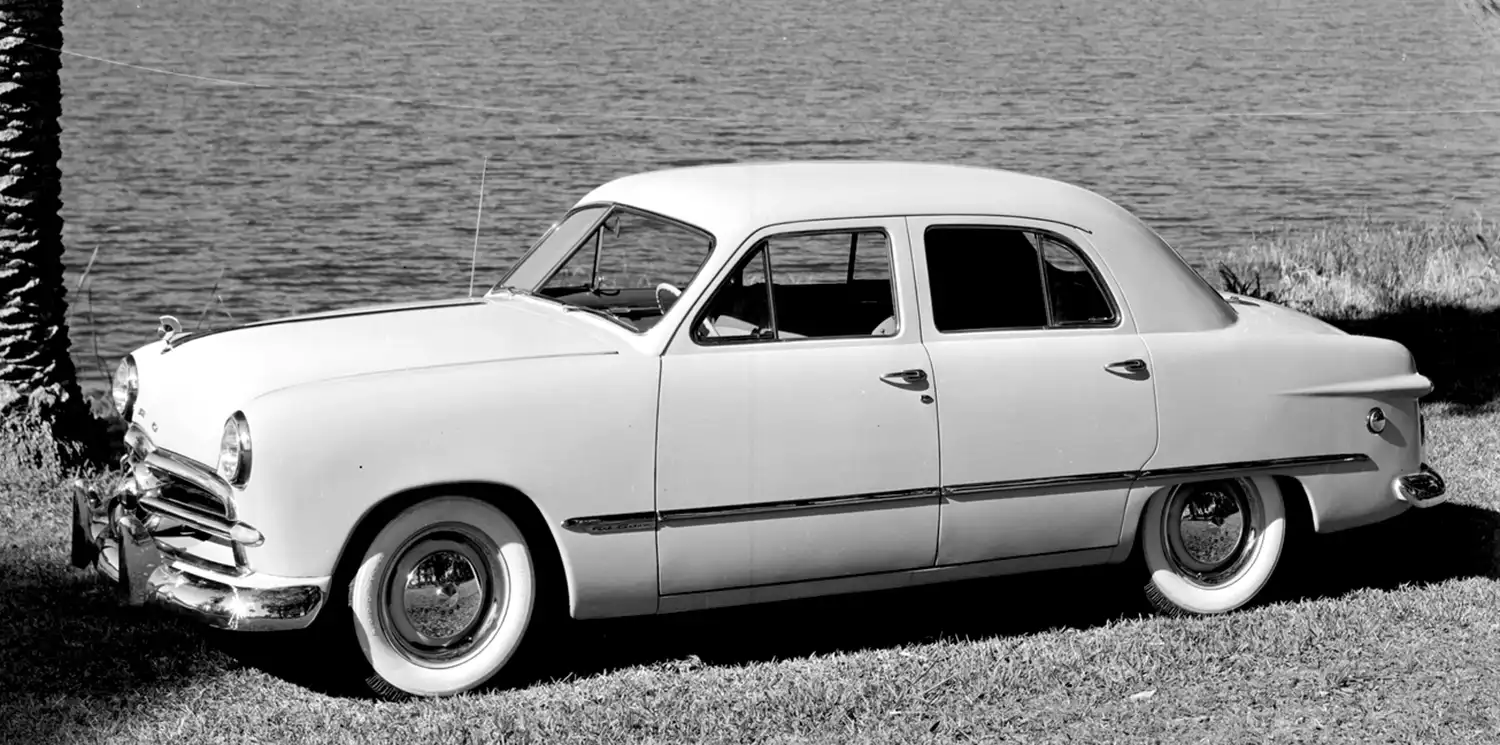
The 1949 Ford Custom four-door holds a significant place in automotive history, representing Ford’s first all-new post-World War II design. This model was part of a lineup that marked a departure from the pre-war styling, embracing a more streamlined and modern aesthetic that captured the optimism of a nation ready for a new era. While the Custom trim sat above the base Standard model, it offered a balance of style and affordability that made it a popular choice for families across America. The four-door sedan configuration prioritized practicality and passenger comfort, solidifying its role as a dependable family car during a period of significant social and economic growth.
Design Revolution: The styling of the 1949 Ford Custom was a dramatic departure from its predecessors. Gone were the upright, boxy shapes of the pre-war era, replaced by smooth, flowing lines and integrated fenders. This “envelope” body style was a hallmark of the post-war automotive design trend, and the Ford Custom embraced it wholeheartedly. The car featured a prominent horizontal grille, integrated headlights, and a lower, wider stance that conveyed a sense of modernity and progress. Chrome accents were tastefully applied, highlighting the car’s sleek silhouette without being overly ostentatious. The four-door sedan body offered easy access to a spacious interior, making it a practical choice for families and those needing comfortable passenger transport.
Under the Hood: The 1949 Ford Custom was typically powered by a choice of engines, reflecting Ford’s commitment to providing options for different needs and budgets. The standard engine was usually a 226 cubic inch L-head inline six-cylinder, known for its reliability and fuel efficiency. For those seeking more power, a 239 cubic inch flathead V-8 engine was also available. This V-8, a Ford staple for many years, delivered increased horsepower and torque, providing a more spirited driving experience. Horsepower figures for the six-cylinder generally ranged around 95, while the V-8 produced approximately 100 horsepower. These engines were mated to a three-speed manual transmission, with overdrive available as an option for improved fuel economy on the open road. Performance figures for the era were modest by today’s standards, but the focus was on dependable power and smooth operation for everyday driving.

Interior Comfort and Features: Inside, the 1949 Ford Custom offered a comfortable and functional environment. The four-door sedan provided ample seating for five or six passengers, depending on whether a bench seat or individual seats were chosen for the front. Upholstery options typically included durable fabrics in various colors and patterns. The dashboard featured a clean and straightforward design, with essential gauges centrally located for easy readability. While not laden with the power amenities of later decades, the Custom often included features like a heater, defroster, and a radio as optional extras, enhancing the driving experience. The emphasis was on practicality and durability, reflecting the needs of post-war families.
Legacy and Impact: The 1949 Ford Custom four-door played a crucial role in Ford’s post-war success and helped to shape the automotive landscape of the 1950s. Its modern styling resonated with a public eager for new designs after years of wartime production. The car’s reliability and affordability made it accessible to a wide range of buyers, contributing to Ford’s strong sales figures during this period. The design cues introduced on the 1949 models would influence Ford’s styling for years to come. Furthermore, the Custom trim level became a staple in Ford’s model lineup, representing a popular balance between features and price. The 1949 Ford Custom four-door is remembered today as a symbol of post-war optimism and a significant milestone in Ford’s history, demonstrating the company’s ability to adapt to changing times and provide vehicles that met the needs of the American public. Its blend of modern design, reliable performance, and practical features solidified its place as an automotive icon of its era.
Summary
- First all-new post-World War II design for Ford.
- Introduced a streamlined “envelope” body style.
- Offered with a 226 CI inline six-cylinder or a 239 CI flathead V-8 engine.
- Typically equipped with a three-speed manual transmission (overdrive optional).
- Prioritized interior space and passenger comfort.
- Featured a clean and functional dashboard design.
- Represented a balance of style and affordability.
- Contributed significantly to Ford’s post-war success.
- Influenced Ford’s styling in the subsequent years.
- The Custom trim became a long-standing part of Ford’s lineup.
Disclaimer: Information provided is for general informational purposes. Vehicle details can vary. Verify specifics with reliable sources.
Source: Ford Heritage Vault
AI Assistance: Gemini
